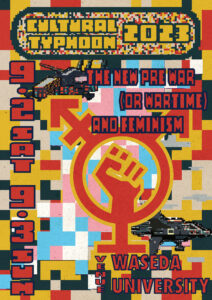CT2023 ポスター公開&基調対話・シンポジウムの詳細について
post on : 2023.08.04
みなさま
2023年9月2日〜3日に早稲田大学で開催されますカルチュラル・タイフーン2023のポスターを公開いたします。
またポスター公開にあわせまして基調講演・シンポジウムの詳細も公開いたします。
どうぞご確認くださいませ。
*大会タイムテーブル(個人発表・グループ発表等)はこちら
→https://docs.google.com/spreadsheets/d/19443gOzqosJNmdBplVh_iQQZEWoFcIgjQqyprjYFK7A/edit?usp=sharing
*大会参加チケットのご購入はこちら
→https://peatix.com/event/3645053
PDF版はこちら↓↓↓
PDF版のリンク
基調対話
日時:2023年9月2日 13時~15時
東アジアにおける新しい戦(中)前とフェミニズムをめぐる対話:陳光興をむかえて
A Dialogue on the New Pre-war (Or Wartime) and Feminism, with Kuan-hsing Chen
登壇者:
陳光興(台湾・国立交通大学社会文化研究所・インターアジアカルチュラル・スタディーズ)
伊藤守(早稲田大学)
田中東子(東京大学)
司会:
小笠原 博毅(神戸大学)
東アジアにおける「軍事的脅威」の喧伝、それを受けての軍事費の増強、監視体制の整備、国境の再強化、国民動員への布石は着々と進む。これは「新しい戦前」なのか、すでに戦争は始まっている(戦中)のか。この事態を東アジアの旧植民地諸国と日本の関係に位置づけ、そこにいまやカルチュラル・スタディーズ運動の基幹となったフェミニズムをぶつけて理解と打開を試みる早稲田タイフーンのメイン企画。インター・アジアのカルチュラル・スタディーズを牽引してきた陳光興による問題提起によって口火が切られる。
We are in a situation in which military threat propaganda, rapid rise of military budget, surveillance and control society, and reinforcement of national border, all these are on-going to make national mobilisation realistic. Are they new pre-wartime symptoms? Or are we already in a wartime? At the main dialogic symposium of this year’s Cultural Typhoon, this situation is examined in the context of inter-relationships between ex-east Asian colonies of the Japanese Empire and the old coloniser Japan with a help of feminism that has recently become the chief backbone of cultural studies in Japan. The dialogue will be launched by Kuan-hsing Chen who has been an inspiration figure for a long time in the Inter-Asia Cultural Studies sphere.
シンポジウムA
日時:2023年9月3日 10時~12時
消される言葉/想起する表現――関東大震災100年後の東京で
Deleted Voices, Recalling Messages: 100 years after the Great Kanto Earthquake
登壇者:
飯山由貴(美術家)
FUNI(ラッパー)
川端浩平(津田塾大学)
堀真悟(新教出版社)
司会:
浜邦彦(早稲田大学)
今から100年前の1920年代、王子脳病院に2人の朝鮮人患者がいた。しばしばいさかいを起こしては、朝鮮語の歌を歌っていた。診療記録(カルテ)は残っているのに、彼らの朝鮮語も、その歌の意味も、また2人が心を病んだ理由も不明なまま、記録だけが残された。
飯山由貴の映像作品《In-Mates》は、残された記録をもとに、2人の朝鮮人の心と言葉を全身を使って表現しようと試みた、川崎・桜本の在日コリアンラッパーFUNIのパフォーマンスを撮った、26分のフィルムである。
ところが昨年、この作品が関東大震災の朝鮮人虐殺の歴史に触れているという理由で、さらにはFUNIの歌詞が「ヘイトスピーチ」を含むという理由で、東京都人権プラザでの出展を拒否されるという事件が起こってしまった。
何が問題なのか。
関東大震災からちょうど100年後にあたるカルチュラル・タイフーンで、私たちは《In-Mates》を上映し、FUNIの生身のパフォーマンスを体感することで、隣人たちの心や言葉が見えなくなっている今の時代、それゆえに「他者」に対する粗暴なプロパガンダの言葉ばかりが拡散してゆく今の社会――新しい戦(中)前?――に、100年前の光景を重ねつつ、魂をもったラップの言葉が、検閲される表現が、どのような思考の現在や未来を劈(ひら)いているのかを、美術、音楽、コミュニティ、宗教、歴史を横断しながら考察する。
There were two Korean patients at Oji Mental Hospital in the 1920s, about 100 years ago from now. It is recorded that they often had trouble quarreling with each other and used to sing Korean songs. Their medical records do not tell us what they talked and sang in Korean nor what were the causes of their mental illness, because their Korean language was unintelligible for the medical stuff at that time. In-Mates, the video works created by Yuki Iiyama, attempts to recall such voices of two Koreans through performances of a 2.5 generation Zainichi Korean rapper FUNI. Meanwhile, we must note that this work was rejected to exhibit at Tokyo Metropolitan Human Rights Plaza since it dealt with the history of the massacre of Koreans during the Great Kanto Earthquake and FUNI’s lyrics representing two Koreans are regarded as hate speech. What’s going on? In this symposium held 100 years after the Earthquake, we are going to screen In-Mates with a live rap performance of FUNI to recall messages of the past. By articulating the past and the present age of New Pre-war (or Wartime?) when it becomes more difficult to sense the feelings and words of our neighbors while the violent languages of propaganda diffuse over both on streets and cyberspaces. By intersecting the art, music, community, religion, and history, we are going to examine how the language of rap music and the censored art expression illuminate thoughts of present and future.
シンポジウムB
日時:2023年9月3日 16時30分~18時30分
トランスジェンダーの物語とエンパワメント:連帯の歴史を記憶するために
The Stories of transgender and empowerment: remembering the History of solidarity
登壇者名:
高井ゆと里(群馬大学)
三木那由他(大阪大学)
水上文(文筆家)
司会:
TBA
トランスジェンダーの物語はこれまでも紡がれてきたし、今も、紡がれている。トランスジェンダーの人びとの生を軽視したり、差別や偏見につながる言説が多くなる一方で、たしかに紡がれてきた物語は、トランスジェンダーの人びとを勇気づけ、生きるための力をくれるだろう。同時に、ショーン・フェイ『トランスジェンダー問題ー議論は正義のために』(高井ゆと里訳、明石書店、2022年)が明らかにしたようにトランスジェンダーの人びとが解放された世界はほかのマイノリティにとっても生きやすい世界なのだ。だが、考えてみると、家父長制がまかりとおり、経済的格差が広がり、暴力にあふれた世界を変えたいのはわたしたちだけではないだろう。トランスジェンダーの物語がエンパワーするのはほかならないあなたなのだ。
これまでにも、連帯の歴史は続いてきた。その連帯をわたしたちは記憶したい。2022年には、『反トランス差別ZINE われらはすでに共にある』(反トランス差別ZINE編集部=青本柚紀、高島鈴、水上文)が刊行され、2023年8月に増補版『われらはすでに共にある:反トランス差別ブックレット』(現代書館)が刊行された。『シモーヌ』Vol.5で、高井ゆと里が書いた「時計の針を抜く:トランスジェンダーが閉じ込めた時間」にあるように、トランスジェンダーの人びとはブログやSNSで豊かな言葉を紡いできたし、ほかにも多くの多様な表現があったことも重要である。文芸誌『すばる』2023年8月号では「トランスジェンダーの物語」特集が組まれ、周司あきら、高井ゆと里『トランスジェンダー入門』(集英社新書、2023年)が刊行され、エンパワメントは現在進行形で続いている。
だが、わたしたちが記憶しなければならないのは、連帯して迫害に抗ってきた歴史だ。作家の李琴峰は、「朝日新聞」(2023年5月12日)の記事「LGBT迫害から立ち上がる シドニーで見た歴史への敬意」で、世界最大規模のLGBTの祭典マルディ・グラを訪れたときに見た、シドニーのボンダイビーチの崖の上にある追悼記念碑に刻まれた言葉を踏まえてこう書いている。「記念碑の名は、「Rise」――蜂起する、立ち上がる、の意だ。LGBTは人間の歴史を通して一緒くたにされて迫害を受け、それでも何度も強く立ち上がって闘ってきた。これからも連帯のために手を携えて生きていくだろう。私はそう信じている」。物語はエンパワメントする。物語は抵抗する。物語は連帯する。そのためには、歴史を学び、伝え、記憶する必要がある。このシンポジウムが目指すのは、その可能性である。
People have spun the stories of transgender and keep on spinning today. While the discourse that belittles the life of transgender people and causes more discrimination and prejudices has increased, these stories will encourage transgender people and give them the power to live. At the same time, as Shon Faye revealed in “The Transgender Issue: An Argument for Justice” (Yutori Takai [Translator], Akashi-shoten, 2022), any other minorities also can live comfortably in the world that liberates transgender people. But, it would not only be us who want to change the world with patriarchy remaining, widening economic inequality, and filled with violence. It is no one but you that transgender stories empower.
The history of solidarity has lasted in the past as well. We want to remember that solidarity in our hearts. In 2022, Gendai-shokan published “Han toransu sabetsu-jinn – warera wa sudeni tomo ni aru (Anti-Transphobia Zine – We are already together),” and the release of the enlarged edition was in August 2023. As Yutori Takai wrote in “Tokei no hari wo nuku – toransujendaa ga tojikometa jikan (Pulling out the hands of a clock – the time that transgender locked up)” in “Les Simones” vol.5, it is important to note that transgender people have weaved their words through blogs and social media, and plenty of other various expressions have been created. The literary magazine Subaru featured “The story of transgender” in the August 2023 issue, and “Toransujendaa nyumon (The introduction to transgender)” (Shueisha-shinsho) by Akira Shuji and Yutori Takai was also published in 2023, indicating that the empowerment is ongoing right now.
However, what we should keep in mind is the history of resisting persecution through solidarity. In the article of the Asahi Shimbun, May 12, 2023, “LGBT hakugai kara tachiagaru – shidonii de mita rekishi eno keii (Standing up from the persecution of LGBT – the respect to the history that I saw in Sydney),” the writer Kotomi Li describes as follows, with referring to the word engraved on a monument on the cliff in Bondi Beach, Sydney. “Rise” is the monument’s name, which means to revolt and stand. Throughout the history of humanity, LGBT has been persecuted and lumped up together, nevertheless standing up and fighting.
I believe that they will hold hands and live together for solidarity.” A story empowers. A story resists. A story solidifies. Thus, we need to learn history, pass it to the next generation and remember it. The goal of the symposium is that possibility.



